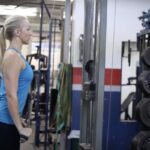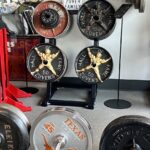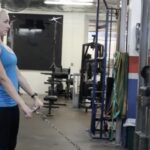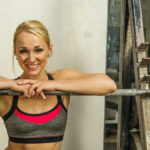Home gym ideas, garage edition! Home gyms are the most fun! I am a huge proponent of having your own home gym, whether it’s in a spare room, a back yard shed, or in your garage.
People get caught up in the pros and cons of a home gym, or a garage gym vs gym membership, or what’s the best equipment for home workouts? There are a million answers to these questions, and the good news, there are lots of ways to get it right!
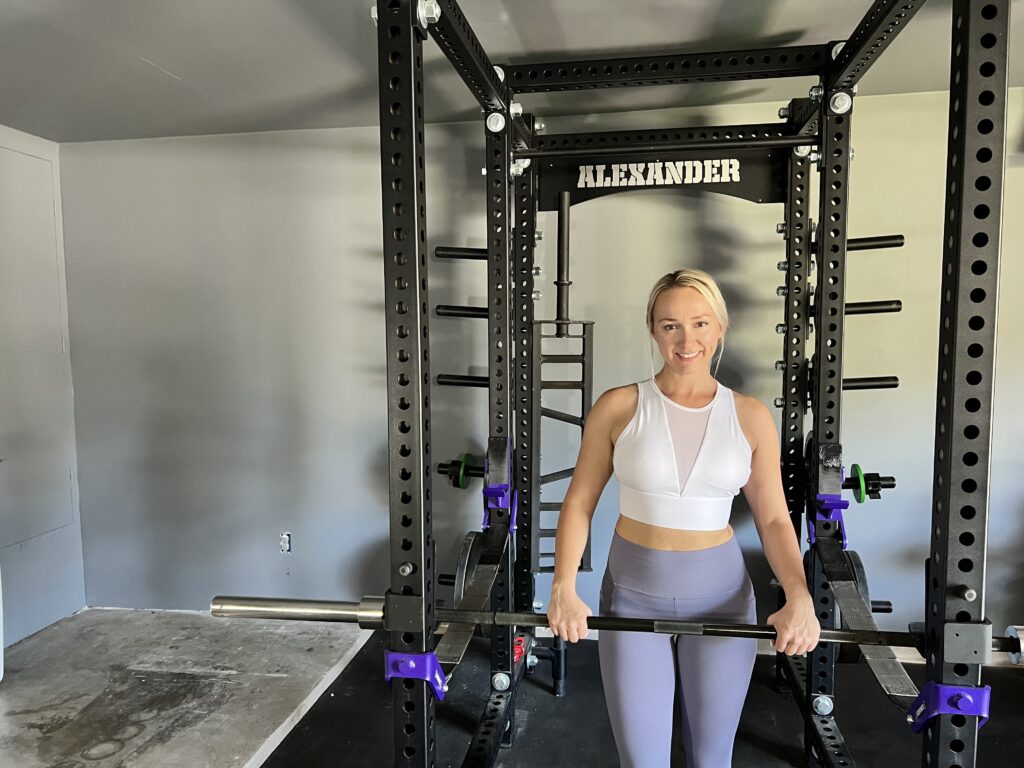
If you need home gym ideas, garage gym ideas, or just want to brainstorm, please read along! You are truly only limited by your imagination! And maybe budget, but we’ll address that too.
Some links in this post are Amazon affiliate links to products that I love and regularly use.
I have put quite a bit of effort and investment into my garage gym. I have a two-car garage, and though I have somewhat limited space, I can park my truck in one side, and house all my home gym equipment on the other. It allows for me to use my own garage gym for good workouts, and active lifestyle, and spending time in a private space. Sometimes there are just so many people out there in public gyms, you know?
The great thing is that this also allows me to maintain my own equipment. I buy quality equipment and treat it well. After all, I intend to use it for a long time!
Build Your Dream Garage Gym
The best thing about the millions of options when building your home gym is that you can perfectly and precisely tailor it to you. I encourage you to think about what would be the most fun thing for you to be able to train at home. What would be the best thing that you look forward to having the freedom to do in the comfort of your own home?
That seems easy enough, but sometimes it’s hard to think that big, or get that creative! That’s ok! Just start thinking on that as you read the following ideas for how to make your home gym or garage gym the best facility for you!
Why Should You Have a Home Garage Gym?
- No commute!
- Save time!
- No waiting for equipment!
- No weirdos! (Unless you invite them over)
- Nobody else’s sweat!
- No distractions!
- All the equipment you have picked!
- Your own music!
- Your own lighting!
- Solitude! Or, invite your friends!
I could go on about what makes a garage gym so great! The convenience of skipping the commute and time can really increase your consistency in training. You can really find tune all the details of your gym too: like I mentioned, the music decisions are yours. You can put the fans and heaters on how you’d like. No weather’s going to stop you from training!
Of course, a garage home gym is private and comfortable too. You can really focus on your own workouts without the distractions of a public commercial gym.
Notice I didn’t say this really saves you money, because it can really put a dent in your fun budget, if you know what I mean. It saves you so much time! But not much money. Yes, if you forego your gym memberships, you’ll save a bit of that recurring cost. And weights last forever; if you take good care of your equipment, you can pass it on to your grand kids, and I’m not exaggerating.
Probably most importantly, having a dedicated workout space at home encourages a healthy lifestyle, making it easier to integrate exercise into your daily routines. This is probably the most important thing for building your health, strength, and reaching your fitness goals.
What Is Your Training Style?
Alright, let’s get down to details. As you read this, consider what equipment you need for your home garage gym. Remember that question I asked, about what would be the best thing you can have readily accessible, to train with? That’s what we need to think about now. Are you a cardio, high reps, high volume kind of exerciser? If so, you might be able to build your dream garage gym space with floor mats, resistance bands, jump ropes and some light dumbbells or kettlebells. If this is your style of activity, you just need extra space to do your work.
If your idea of an awesome workout is a powerlifting style training session, then you’ll need a squat rack, lots of metal plates, and a good barbell or two. Similarly, if you’ll be doing Olympic lifting/weightlifting, you’ll need a quality barbell, bumper plates, and some open space to move around as well.
If you are training primarily for hypertrophy or physique goals, then you’ll want free weights, resistance bands, and maybe a few specialty pieces of equipment. You might not need a full power rack but you’ll need more weights than people who are primarily working conditioning or cardiovascular training.
Finally, the more athletic your goals are, the more floor space you will need. If you can open your garage door, you can open up a small space for a little more room. That might help expand your training options.
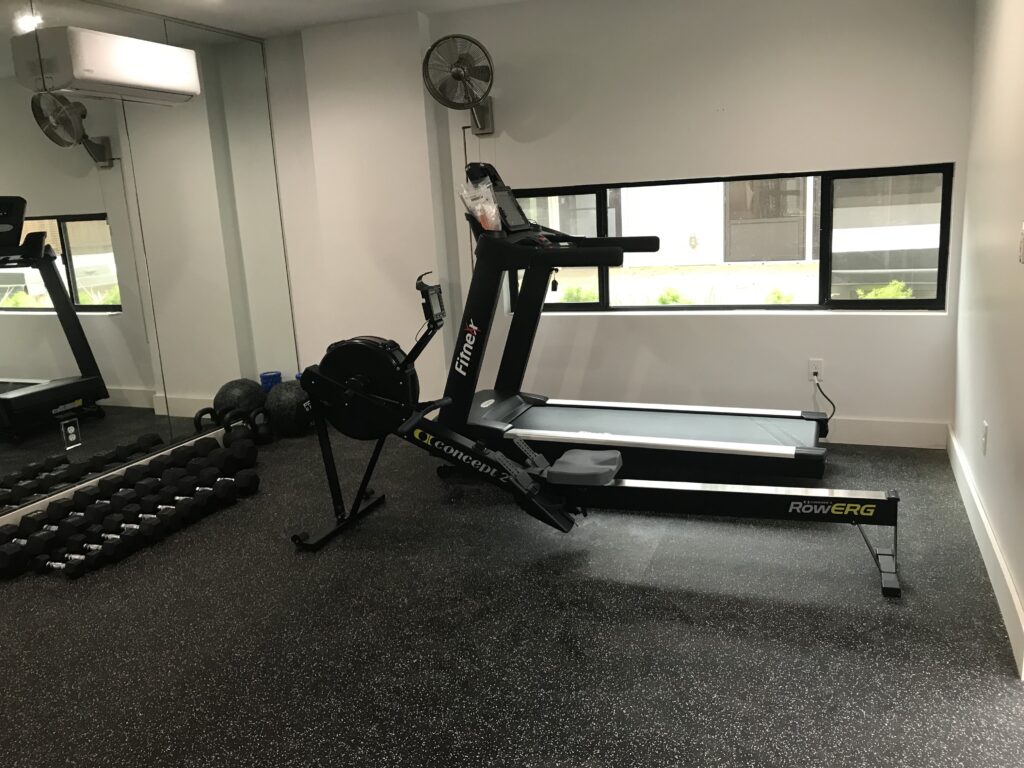
Home Gym Ideas for All Training Styles
Before we get into specifics, let’s talk about the kinds of equipment you’ll need that will apply to all kinds of training. In a nutshell, this means:
- safe and durable flooring
- storage space
- good quality exercise equipment
Flooring For Your Home Gym
When building a home gym, choosing the right flooring is crucial for protecting your equipment, reducing noise, and ensuring safety. Most garages have concrete flooring, so it’s particularly important to add some kind of protective layer. Here’s why and what to consider:
Why You Need Mats or Flooring Over Concrete:
- Shock Absorption: Concrete is hard, offering no cushioning. Using mats or gym flooring will absorb impact from exercises like lifting weights or jumping, which can reduce the risk of injury and protect your joints.
- Protect Equipment: Dropping weights on concrete can damage the equipment and the floor itself. Mats help to cushion the impact and prevent damage.
- Noise Reduction: Mats can help reduce noise when moving or dropping weights, which is particularly useful if your gym is located near living spaces.
- Comfort: Mats provide a more comfortable surface for exercises like yoga, stretching, or bodyweight workouts.
- Anti-Slip Surface: Concrete can be slippery, especially if you sweat during workouts. Mats with textured surfaces provide grip and reduce the risk of slipping.
Recommended Types of Flooring for Home Gyms:
- Rubber Flooring:
- Durability: Rubber is the most common material used in gym flooring because it’s durable and provides good shock absorption.
- Thickness: Thicker rubber (8mm to ¾ inch or more) is ideal for heavy lifting areas, while thinner rubber (6mm) works for cardio and general fitness areas.
- Rolls or Tiles: You can buy rubber flooring in rolls (for covering large areas) or tiles (for more customizable spaces). Tiles are easier to install.
- Foam Mats:
- Lightweight Use: Foam tiles or mats are great for light exercises like yoga, stretching, or bodyweight exercises but not recommended for heavy weights as they may dent or wear down.
- Interlocking Design: These mats usually have an interlocking puzzle design, making them easy to install and replace if damaged.
- PVC or Vinyl Flooring:
- For Multipurpose Areas: These materials offer a more polished look and are durable. They are good for areas used for multiple purposes beyond just fitness (e.g., garages).
- Less Shock Absorption: They aren’t as shock-absorbent as rubber but are good for areas where you won’t be dropping heavy weights.
- Horse Stall Mats:
- Cost-Effective Option: These are thick, durable rubber mats commonly used in gyms. They are cheaper than gym-specific rubber flooring but offer similar protection.
- Size: They typically come in larger 4’x6’ sections and can cover a significant area.
What to Consider:
- Thickness: For weightlifting or using heavy equipment, go for 8mm or thicker rubber mats. These are a bit more heavy duty. If you’re doing mostly cardio, bodyweight exercises, or lighter weight training, 6mm to 8mm mats should suffice.
- Area of Use: You can use thicker mats in specific areas where you do heavy lifting and thinner, less cushioned mats for stretching or cardio zones.
If you have a concrete floor, rubber mats or horse stall mats are highly recommended to prevent damage to the concrete and equipment, as well as to provide better comfort and shock absorption.
I have stall mats from Tractor Supply. You can also get good mats from Home Depot or Amazon.
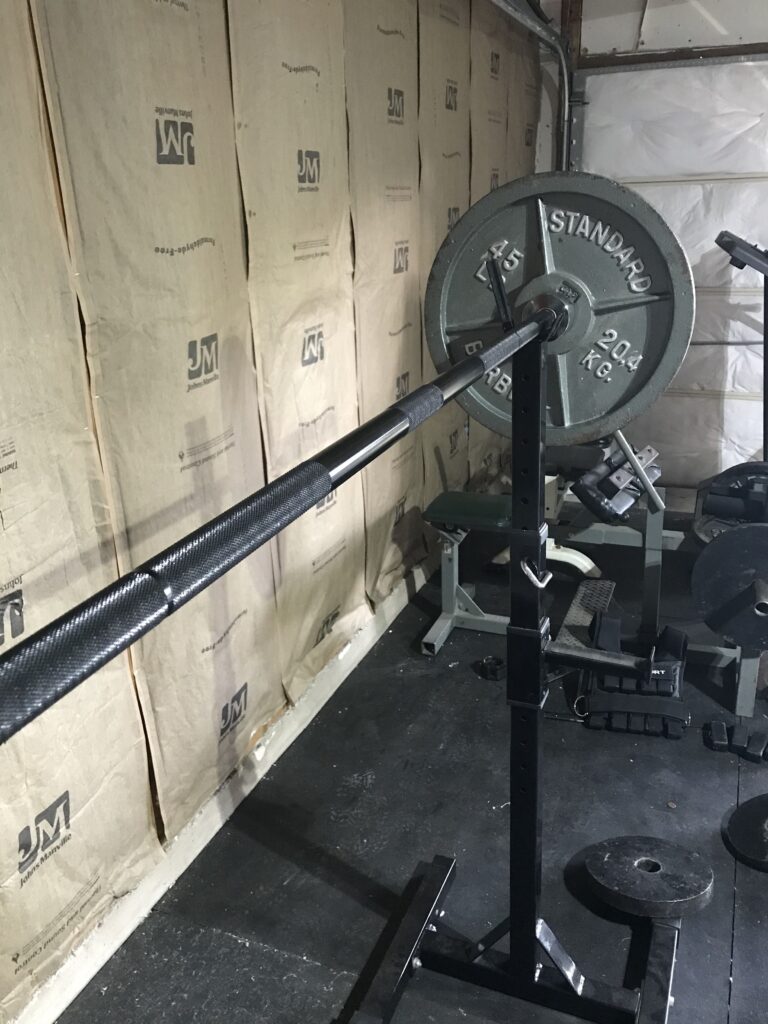
Equipment Storage
Organizing a garage space/home gym efficiently is key to keeping your workout space functional, safe, and clutter-free. Here are some essential storage solutions for common gym equipment, including barbells, plates, and accessories:
1. Barbell Storage
- Vertical Barbell Holder (Barbell Rack): These hold barbells vertically to save floor space. They typically hold multiple barbells (2, 4, or even more). This type of storage also protects the barbell’s knurling and keeps them from rolling around.
- Horizontal Wall-Mounted Barbell Rack: Also called barbell gun racks, these racks mount on the wall and hold the barbells horizontally. They’re great if you have more wall space and want easy access to the bars.
- Floor-Mounted Barbell Rack: If you don’t want to mount anything on the wall, floor racks can store barbells horizontally on the ground. Some also come with additional storage for other equipment like plates or collars.
2. Weight Plate Storage
- Plate Tree (Vertical Plate Storage): A plate tree is a vertical storage unit with arms for organizing different-sized plates. It keeps your plates off the floor and makes them easy to access.
- Wall-Mounted Plate Storage Pegs: If you want to save floor space, wall-mounted pegs allow you to store your weight plates on the wall. They are especially helpful for keeping bumper plates organized.
- Power Rack with Plate Storage: Many power racks come with built-in plate storage attachments, so you can store your plates right on the rack without needing additional equipment.
- Rolling Plate Rack: This mobile storage option is great for easily moving weight plates around the gym, especially if you have a larger space.
3. Dumbbell and Kettlebell Storage
- Dumbbell Rack: A 2- or 3-tier dumbbell rack is essential for keeping your dumbbells organized. They’re available in different sizes depending on how many dumbbells you have.
- Kettlebell Rack or Shelf: Kettlebells can be stored on either a dedicated rack or a multi-purpose shelving unit. Some racks have flat shelves to accommodate various sizes.
- Wall-Mounted Kettlebell Hooks: If floor space is limited, you can install wall-mounted hooks specifically designed to hold kettlebells.
4. Resistance Bands and Small Accessories
- Wall-Mounted Pegboard: A pegboard with hooks is perfect for storing resistance bands, jump ropes, collars, lifting belts, and other smaller accessories. It keeps them organized and easy to access. Bands are crucial for back exercises, which are sometimes harder to do at home.
- Over-the-Door Storage Rack: These racks have hooks or mesh compartments to store bands, towels, or smaller gym items, and they can be easily hung over a door in your gym.
- Storage Bins or Baskets: Stackable bins or baskets can store miscellaneous items like foam rollers, yoga blocks, or smaller pieces of equipment.
- Drawer Units or Shelves: Small drawer units or shelves can help keep accessories like chalk, wrist wraps, lifting straps, and other items organized and easy to reach.
5. Medicine Ball and Slam Ball Storage
- Ball Rack: A vertical or tiered rack designed to hold medicine balls, slam balls, or wall balls can keep these pieces organized and prevent them from rolling around.
- Wall-Mounted Ball Storage: Wall-mounted holders are also an option to keep balls off the floor and save space.
6. Storage for Mats and Foam Rollers
- Wall-Mounted Mat Hooks: Mats can be hung on hooks or rails to keep them off the floor and to ensure they don’t take up unnecessary space.
- Foam Roller Stand or Wall Rack: You can get a small rack or holder that keeps foam rollers standing upright. Some wall-mounted racks can also hold rollers alongside mats or bands.
7. Power Rack Storage Attachments
- Power Rack Storage Attachments: Many modern power racks offer attachment options for storing accessories like resistance bands, weight plates, barbells, or even landmine attachments. This can maximize space and reduce clutter in your gym.
8. Wall-Mounted Shelves or Cabinets
- Multi-Purpose Shelving: For items like water bottles, towels, or tech (phones, headphones, etc.), wall-mounted shelving units or cabinets can keep everything tidy and off the floor.
9. Collar and Clip Storage
- Magnetic Wall Mounts: Magnetic storage solutions for collars and clips can attach them directly to a rack or the wall, making them easily accessible.
- Small Hooks or Bins: You can also use small hooks or bins specifically for your collars, which can be mounted on a wall or attached to a rack.
10. Multi-Purpose Storage Benches
- Storage Bench: A flat or adjustable bench that doubles as a storage compartment can hold smaller equipment like resistance bands, wraps, or dumbbells. This is a great way to save space while adding utility to your bench.
Whether you are training for specific competitive goals, or training to increase health of fitness, there are some pieces of equipment you will need regardless. In various strength training disciplines like powerlifting, Olympic weightlifting, bodybuilding, and general strength training, several pieces of equipment are essential, despite the differences in technique, goals, and training styles.
Here’s a list of equipment that is commonly used across these disciplines:
1. Olympic Barbell
- Description: The Olympic barbell is a staple across almost all forms of lifting. It typically weighs 20 kg (45 lbs) for men and 15 kg (33 lbs) for women. The sleeves of the bar rotate (bearings or bushings), which is crucial for exercises like cleans and snatches.
- Use Across Disciplines:
- Powerlifting: Used for squats, bench press, and deadlifts.
- Olympic Lifting: Central to movements like the snatch and clean & jerk.
- Bodybuilding & General Strength: Used for a wide range of compound and isolation exercises.
2. Weight Plates (Bumper Plates or Metal Plates)
- Description: Plates are needed to load the barbell, and they come in different materials. Bumper plates are rubberized and designed to be dropped safely, while metal plates are often used for powerlifting and bodybuilding.
- Use Across Disciplines:
- Powerlifting: Metal or iron plates are typically used for precise weight loading in squat, bench, and deadlift.
- Olympic Lifting: Bumper plates are essential to allow for the bar to be safely dropped during cleans, snatches, and jerks.
- General Strength & Bodybuilding: Both types are used depending on the exercise and preference.
3. Squat Rack / Power Rack
- Description: A sturdy frame with adjustable safety bars and pins for holding the barbell at different heights. This allows for safe squatting and other lifts like bench presses and overhead presses. The best squat racks are heavy, sturdy, and safe. If you don’t want a whole squat cage or power rack, you can use a squat stand.
- Use Across Disciplines:
- Powerlifting: Essential for squats and often for bench press.
- Olympic Lifting: Often used for squats (front and back) as part of strength development.
- General Strength & Bodybuilding: Used for squats, presses, and even pull-ups if it has a bar attachment.
4. Weightlifting Shoes
- Description: Specialized shoes with a raised heel that helps lifters maintain better form, especially in squats and Olympic lifts, by allowing for better ankle mobility.
- Use Across Disciplines:
- Powerlifting: Often used during squats for improved depth and form.
- Olympic Lifting: Essential for snatches, clean & jerks, and squats.
- General Strength: Some lifters use them for squats and overhead presses.
5. Chalk
- Description: Lifting chalk (magnesium carbonate) helps to improve grip by reducing sweat on the hands.
- Use Across Disciplines:
- Powerlifting: Common for deadlifts and other heavy lifts to enhance grip.
- Olympic Lifting: Essential for cleans, snatches, and jerks.
- General Strength & Bodybuilding: Used by some lifters for grip-intensive exercises like deadlifts or pull-ups.
6. Lifting Belt
- Description: A weightlifting belt helps stabilize the core and reduce stress on the lower back by providing intra-abdominal pressure during heavy lifts.
- Use Across Disciplines:
- Powerlifting: Heavily used for squats and deadlifts.
- Olympic Lifting: Some lifters use it for clean & jerk or snatch, especially during heavy sets.
- General Strength & Bodybuilding: Optional but commonly used during heavy compound lifts like squats and deadlifts.
7. Collars/Clips
- Description: Collars or clips secure the plates on the barbell to prevent them from sliding off during lifts.
- Use Across Disciplines: Used universally across powerlifting, Olympic lifting, bodybuilding, and general strength training to secure weight plates during lifts.
8. Bench
- Description: A flat or adjustable bench is used for exercises like the bench press and a variety of other pressing and pulling exercises. I have a bench from Sorinex and a bench from Fringe sport. I love both.
- Use Across Disciplines:
- Powerlifting: Essential for the bench press.
- General Strength & Bodybuilding: Used for bench press, incline press, dumbbell exercises, and more.
9. Resistance Bands
- Description: Bands add resistance or assistance in lifts. They can be used for mobility work, warm-ups, or to change the resistance curve of an exercise (accommodating resistance).
- Use Across Disciplines:
- Powerlifting: Used for accommodating resistance (e.g., banded squats, deadlifts) or warm-ups.
- Olympic Lifting: Often used for mobility work or warm-ups.
- General Strength & Bodybuilding: Common for warm-ups, mobility, or even adding resistance to lifts.
10. Kettlebells and Dumbbells
- Description: While barbell training is central, kettlebells and dumbbells are used to supplement training and for accessory work.
- Use Across Disciplines:
- Powerlifting: Used for accessory exercises like rows, lunges, and presses.
- Olympic Lifting: Often used for mobility and supplemental strength training.
- Bodybuilding & General Strength: Common for hypertrophy work and targeting smaller muscles.
11. Pull-Up Bar
- Description: A pull-up bar is a versatile piece of equipment for bodyweight exercises, often included as part of a power rack.
- Use Across Disciplines:
- Powerlifting & Olympic Lifting: Used for accessory back and grip work.
- General Strength & Bodybuilding: Common for pull-ups, chin-ups, and core exercises.
While each lifting discipline has its unique requirements, these pieces of equipment serve as a foundation for strength training across the board, allowing for versatile and effective workouts regardless of the specific focus.
Related: how to heat a garage gym in the winter
Home Gym Ideas: Garage Decoration
The best part about getting a good workout in your own garage gym is that you are in charge of every last thing. You can take an empty garage and make it the best home gym ever. Hang your motivational posters, decorate your garage walls, and hang that American flag. Play your loud music, crank the air conditioning if you’ve installed one.
These are some of the best garage gym ideas I have! Let me know if I’ve missed an essential piece of equipment, of a fun way you’ve built up your own gym. Happy training in your own garage gym!
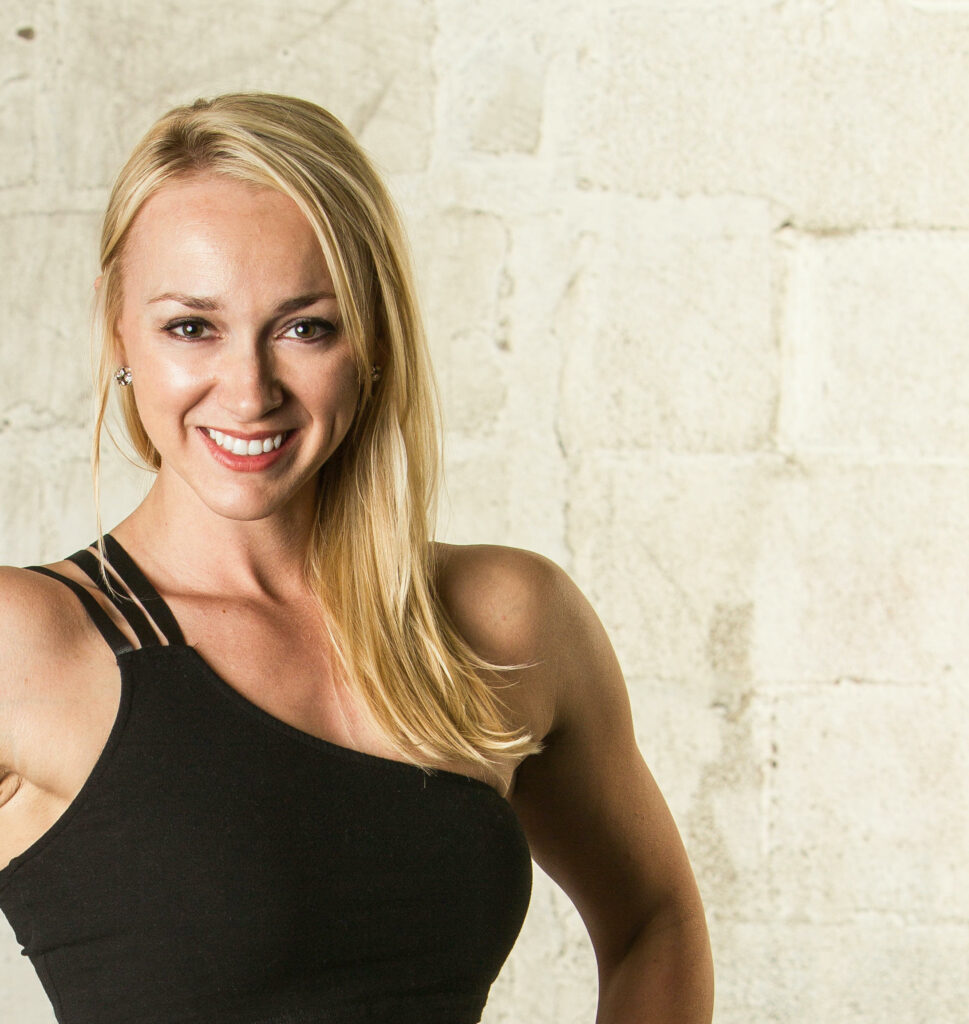
About the author
Kathryn Alexander is a strength coach and personal trainer in Austin, Texas. She loves hiking, college football, and the feel of a perfectly knurled barbell. Read more about Kathryn here.



